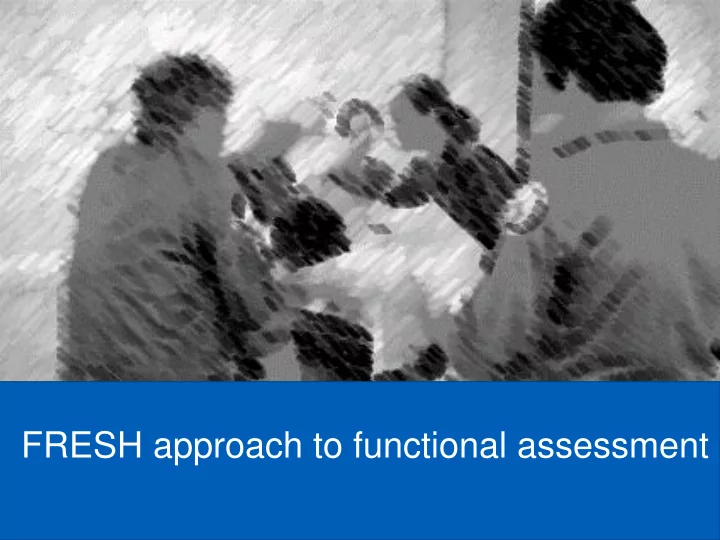

FRESH approach to functional assessment
Consider how we handover our patients in clinical environments. Consider how including additional information about the person can go a long way to impact on outcomes and their future care journey
When a person is brought into ED • Leaving home with returning in mind • What does a patient need to get home? • What do our healthcare professional partners need to do to help a patient return home?
Functional information at A functional conversation handover can: • Maximise the persons chance of avoiding admission • Act as the starting point of the discharge plan.
Many things happen when we talk….. • Record Rockwood frailty score • Early patient engagement – this works both ways. Not only does the professional get the information they need but the person becomes informed and involved in the process • Early family engagement • Consistent early messaging about ‘home first’ • Prevention of later surprises: keys, dislike of the care agency etc • Plan for and prevent deconditioning from earliest stage • Bridge gap between handover and ward – keep the functional story alive • Screening tool feeds daily board round at ward level • Seamless therapy input – not waiting until med fit • Prevents over prescription of care • Screening tool can act as a referral to community
FRESH: Functional Assessment at the front door Function How was the person observed interacting in their environment when the crew arrived? What are their abilities, could they transfer, mobilise, follow instructions, sequence a task and from the patients and carers perspective, how had they been managing for the last few months leading up to this presentation? What is their usual routine? Sometimes, we can be surprised at what the person usually does when we see the person vulnerable in hospital
FRESH: Functional Assessment at the front door Risk Thinking about risks Is there anything that the crews recognise as a risk within the environment, not to stop a discharge but to enable action to be taken to mitigate the risk Are there any obvious risks to the person in their own environment? Is the home cluttered or is the environment creating risk for the person? Is it really a risk or are we applying our own values? What can be done to mitigate the risks? What risks is the person willing to take to go home?
FRESH: Functional Assessment at the front door Equipment Is the person using equipment to mobilise? Is there equipment in place to support with transfers and toileting at home? Are there any major adaptations like stair lifts etc
FRESH: Functional Assessment at the front door Support What support is the person getting at home? Is it informal care via a family, friend or neighbour? Who are they, how are they supporting and how can they be contacted? If it’s a formal agency, can the crew note down the agency name or number that can really help the therapist to restart any care and provide a handover back to the agency Is the patient happy with the care they are receiving?
FRESH: Functional Assessment at the front door Home What is needed to get this person home today ? What are the items the person needs to get back home? Does the person have their keys, footwear and clothes What do they need to get home, type of transport, details around access, is it a flat or house or maisonette?
FRESH: Functional Assessment at the front door Great things happen when we Function talk………. • Record Rockwood frailty score Risk • Early patient engagement – this works both ways. Not only does the professional get the information they need but the person becomes Equipment informed and involved in the process • Early family engagement • Consistent early messaging about ‘home first’ Support • Prevention of later surprises: keys, dislike of the care agency etc Home • Plan for and prevent deconditioning from earliest stage • Bridge gap between handover and ward – keep the functional story alive FRESH handover from ambulance • Screening tool can feed daily board round at crew to therapist can: ward level 1. Maximise the persons chance of avoiding admission • Seamless therapy input – not waiting until med fit 2. Act as the starting point of the discharge plan • 3. Enable the MDT to minimise the risk of Prevents over prescription of care deconditioning • Screening tool can act as a referral to community
Recommend
More recommend